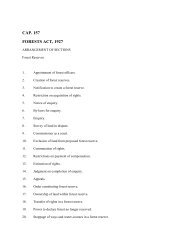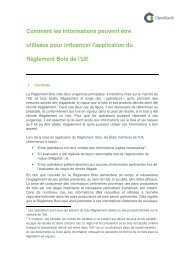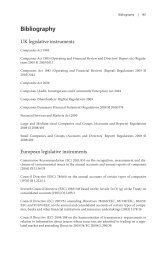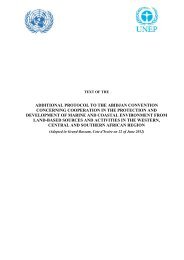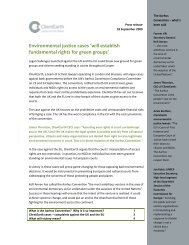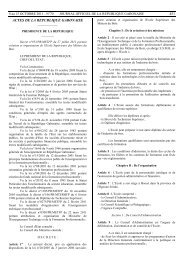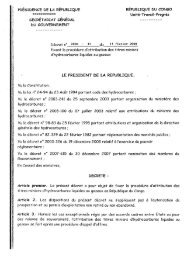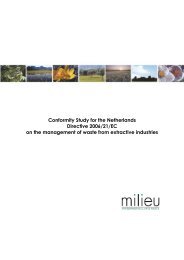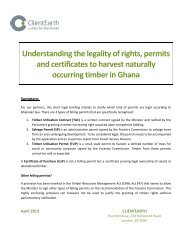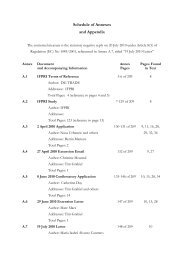Environmental and social transparency under the ... - ClientEarth
Environmental and social transparency under the ... - ClientEarth
Environmental and social transparency under the ... - ClientEarth
- No tags were found...
You also want an ePaper? Increase the reach of your titles
YUMPU automatically turns print PDFs into web optimized ePapers that Google loves.
162 | <strong>Environmental</strong> <strong>and</strong> <strong>social</strong> <strong>transparency</strong> <strong>under</strong> <strong>the</strong> Companies Act 2006Notes | 16341As a rule, without implementation at Member State level, EU Directives can only everhave legal direct effect by creating rights for individuals against <strong>the</strong> State, never againstprivate parties. This distinction is referred to in terms of ‘vertical’ direct effect (against<strong>the</strong> State) <strong>and</strong> ‘horizontal’ direct effect (against a private party). For explanation of whyhorizontal direct effect has not been accepted by <strong>the</strong> courts, see Case 152/84 Marshall vSouthampton <strong>and</strong> South West Hampshire AHA [1986] IRLR 140.42The extent to which a private individual could enforce rights provided by <strong>the</strong> AccountsModernisation Directive against <strong>the</strong> State is not a simple issue, although <strong>the</strong> EuropeanCommission can bring legal action against Member States for failing to implement <strong>the</strong>requirements of a Directive within <strong>the</strong> required time limit.43s 395 Companies Act 2006. The IAS system was created by <strong>the</strong> European Union, pursuantto <strong>the</strong> ongoing objectives of <strong>the</strong> European single market. It was initiated by EuropeanRegulation in 2002. Quoted companies are required to prepare <strong>the</strong>ir consolidated accountsin accordance with IAS st<strong>and</strong>ards, but in <strong>the</strong> case of individual accounts <strong>the</strong>y have <strong>the</strong>choice of Companies Act 2006 or IAS st<strong>and</strong>ards. Where <strong>the</strong> directors of a company prepareIAS individual accounts, <strong>the</strong>y must state as such in <strong>the</strong> notes to <strong>the</strong> accounts (s 397Companies Act 2006).44As made by <strong>the</strong> Secretary of State in exercise of <strong>the</strong>ir powers <strong>under</strong> sections 396(3), 404(3),409(1) to (3), 412(1) to (3), 416(4), 421(1) <strong>and</strong> (2), 445(3)(a) <strong>and</strong> (b), 677(3)(a), 712(2)(b)(i),831(3)(a), 832(4)(a), 836(1)(b)(i) <strong>and</strong> 1292(1)(a) <strong>and</strong> (c) Companies Act 2006. See also SmallCompanies <strong>and</strong> Groups (Accounts <strong>and</strong> Directors’ Report) Regulations 2008 SI 2008/409,applying to small companies in <strong>the</strong> UK.45Soon to be incorporated into a single European Commission Regulation.46See Chapter 3 for fur<strong>the</strong>r discussion.47See IAS 37 Provisions, Contingent Liabilities <strong>and</strong> Contingent Assets (1998), Paragraph 14.48Under ei<strong>the</strong>r <strong>the</strong> Large <strong>and</strong> Medium-sized Companies <strong>and</strong> Groups (Accounts <strong>and</strong> Reports)Regulations 2008 SI 2008/410 Schedule 9, Part 1, Section 2, or IAS 37 Provisions, ContingentLiabilities <strong>and</strong> Contingent Assets, Paragraph 14.49Unless <strong>the</strong> company is subject to <strong>the</strong> small companies’ regime: if it qualifies as ‘small’, orif it is a parent if its group qualifies as ‘small’, so long as specific exceptions do not apply(s 381 Companies Act 2006). A company is ‘small’ if it satisfies 2 of <strong>the</strong> following conditions:turnover not more than £5.6 million; balance sheet total not more than £2.8 million;number of employees not more than 50 (s 382 Companies Act 2006). A parent companyis ‘small’ if its group satisfies two of <strong>the</strong> following conditions: aggregate turnover not morethan £5.6 million net (or £6.72 million gross); aggregate balance sheet total not more than£2.8 million net (or £3.36 million gross); aggregate number of employees not more than 50(s 383 Companies Act 2006). However, no company can be subject to <strong>the</strong> small companiesregime if it is a: public company; insurance, banking, e-money, ISD investment or UCITSmanagement company; or a member of an ineligible group of companies (s 384 CompaniesAct 2006).50s 385 Companies Act 2006 defines ‘quoted company’, for <strong>the</strong>se purposes, as a companywhose equity share capital (a) has been included in <strong>the</strong> official list [i.e. <strong>the</strong> London StockExchange], or (b) is officially listed in an EEA State, or (c) is admitted to dealing on ei<strong>the</strong>r<strong>the</strong> New York Stock Exchange or <strong>the</strong> exchange known as Nasdaq [<strong>the</strong> major US stock markets].51s 417(5)(b) Companies Act 2006.52In this context, metrics used to help define <strong>and</strong> measure <strong>the</strong> development, performanceor position of <strong>the</strong> company in relation to environmental or <strong>social</strong> issues (for example, CO2emissions).53s 417(6) Companies Act 2006.54s 417(3)(a) Companies Act 2006.55s 417(3)(b) Companies Act 2006. For example, companies listed on <strong>the</strong> AIM (AlternativeInvestment Market) are classed as ‘unquoted’ for <strong>the</strong>se purposes, but an AIM-listedmid-size mining company based in <strong>the</strong> UK might well face a ‘principal risk or uncertainty’relating to community opposition or forthcoming environmental regulation in a key areaof operations, in which case <strong>the</strong>y would be required to report <strong>the</strong> issue in accordance withsection 417(3) Companies Act 2006.56s 417(4)(a) Companies Act 2006.57s 417(4)(b) Companies Act 2006.58Department for Business Enterprise <strong>and</strong> Regulatory Reform, ‘Companies Act 2006 Tableof Commencement Dates’ (December 2007).59s 324(1) Companies Act 1985.60s 324(3) Companies Act 1985.61These included details of: matters of a general nature (changes in asset values, directors’shareholdings, political <strong>and</strong> charitable contributions); <strong>the</strong> employment, training <strong>and</strong>advancement of disabled people; <strong>the</strong> health, safety <strong>and</strong> welfare at work of <strong>the</strong> company’semployees; <strong>the</strong> involvement of employees in <strong>the</strong> affairs, policy <strong>and</strong> performance of <strong>the</strong>company.62Company Law Review Steering Group, ‘Modern Law for a Competitive Economy: TheStrategic Framework’, pp. 120-121.63Accounting St<strong>and</strong>ards Board, ‘Reporting Statement: Operating <strong>and</strong> Financial Review’(January 2006) p. 3.64The OFR was developed by <strong>the</strong> Accounting St<strong>and</strong>ards Board (ASB), an operating body of<strong>the</strong> Financial Reporting Council. The ASB’s specific role is to issue accounting st<strong>and</strong>ards.It is a sister body to <strong>the</strong> FRRP (see Chapter 1.2.2 <strong>and</strong> Annex 5).65The Companies Act 1985 (Operating <strong>and</strong> Financial Review <strong>and</strong> Directors’ Report etc)Regulations 2005 SI 2005/1011.



